Visiting the Kiyotsu Gorge Tunnel should be at the top of your list if your travels are bringing you to Niigata Prefecture, Japan.
The Kiyotsu Gorge, also known as Kiyotsukyo in Japanese, is considered one of the ‘Three Great Gorges of Japan’ together with Kurobe and Osugidani. But what makes this attraction interesting is that it combines stunning natural scenery with an interplay between architecture, art and light.
I first learned about the Kiyotsu Gorge when I came across a photo of someone standing at the edge of the tunnel with their silhouette and the greenery of the rocky gorge reflected in a shallow pool of water.
It looked like something out of this world! Was it real? Was it AI? Was it an art museum? Where in Japan was this place located exactly and how easy would it be to get there?
I saved the spot to my GoogleMaps with a little pin for a future trip should I ever be in the area. Well, fast-forward a few months and I was actually planning a trip to Japan together with my husband.
When I saw that our travels would be bringing us to Niigata Prefecture, I made sure we detoured to this very spot!
In this blog post, I’ll tell you exactly how to get to the Kiyotsu Gorge Tunnel and what you can expect once you arrive.
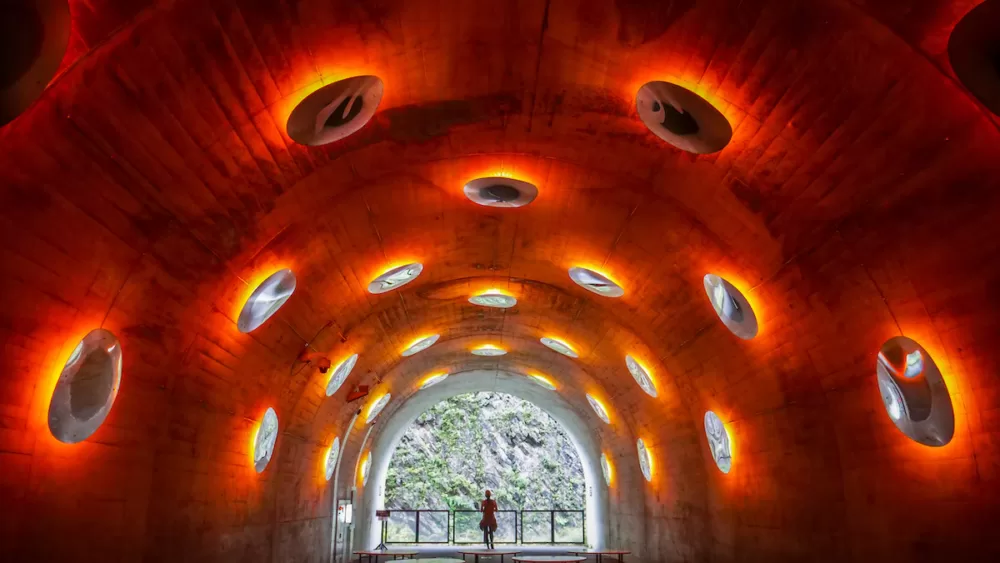
Getting to Kiyotsu Gorge Tunnel
By train and bus
Take the Joetsu Shinkansen to Echigo Yuzawa Station. Once you exit, you’ll walk out to the bus terminal located directly in front of the train station.
You’ll want to take the bus bound for Morinomiyahara Station departing from Platform 4. Confirm with the driver that the bus you’re boarding does in fact go to Kiyotsu Gorge as there are other buses departing from the same platform.
It is a 30-minute bus ride and you’ll get off at Kiyotsukyo Iriguchi (Kiyotsu Gorge Entrance). From there, it is a 20-minute walk to the Kiyotsu Gorge Tunnel.
Tip: Because this bus is a bit infrequent, you’ll want to check the schedule ahead of time and make sure you’re arriving at Yuzawa Echigo Station with enough time to catch the bus. Alternatively, if you miss the bus, you can take a taxi to Kiyotsu Gorge.
By car
If you have a car, you can reach the Kiyotsu Gorge by exiting the Kan-Etsu Expressway at Shiozawa-Ishiuchi and taking Route 353 for about 20 minutes.
There is free parking available on site with overflow lots should it be peak time.
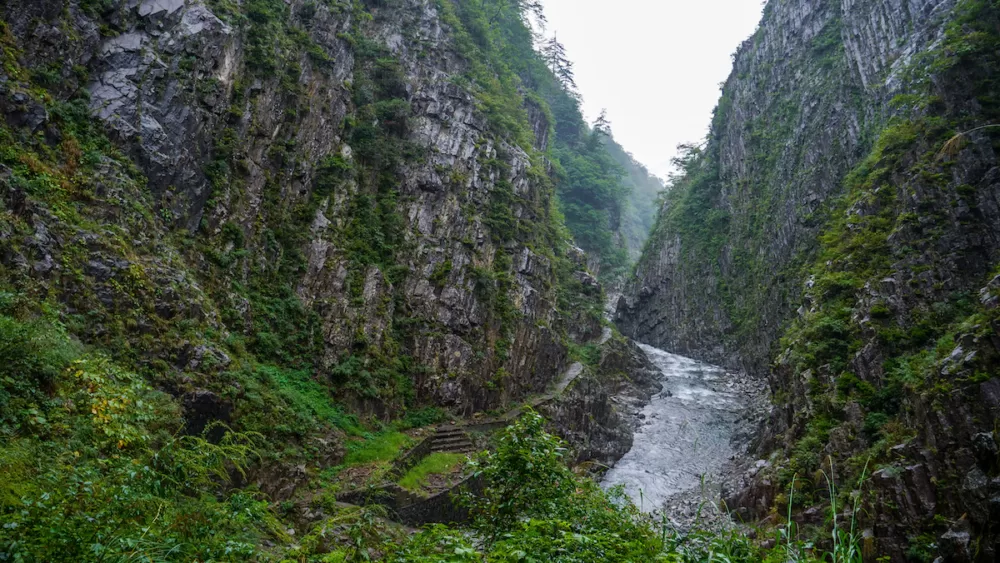
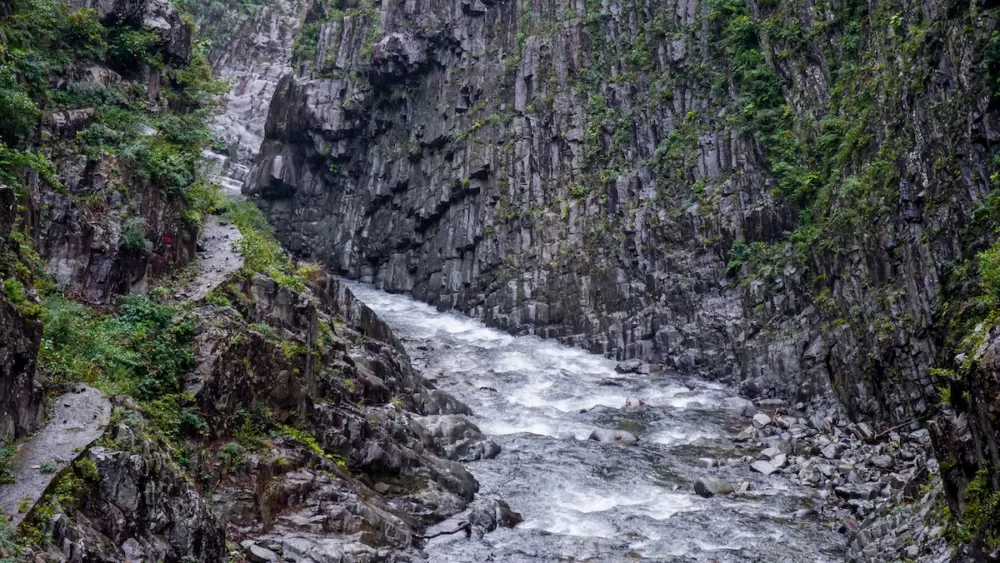
About Kiyotsu Gorge Tunnel
Kiyotsu Gorge is famous for its crystal-clear waters, steep cliffs, and unique rock formations. The gorge stretches approximately 12.5 kilometres and is a product of volcanic activity in the region. The sheer rock walls and the varying shades of green from the surrounding forest create a breathtaking view.
Kiyotsu Gorge was designated a Natural Monument in April 1941 and was made a part of Jōshin’etsukōgen National Park in September 1949.
A highlight of Kiyotsu Gorge is the Tunnel of Light, a 750-meter-long tunnel that was renovated and transformed into an art installation for the Echigo Tsumari Art Triennale in 2018.
This tunnel has several artistic spaces, each offering a different perspective of the gorge and a unique sensory experience. There are mirrored walls, viewing platforms, and soundscapes to enjoy as you make your way down the tunnel. These installations are designed to enhance the natural beauty of the gorge and create a dialogue between art and nature.
Kiyotsu Gorge can be visited as a day trip from Yuzawa, and you have a few days in town, here are some ideas of things to do in Yuzawa.
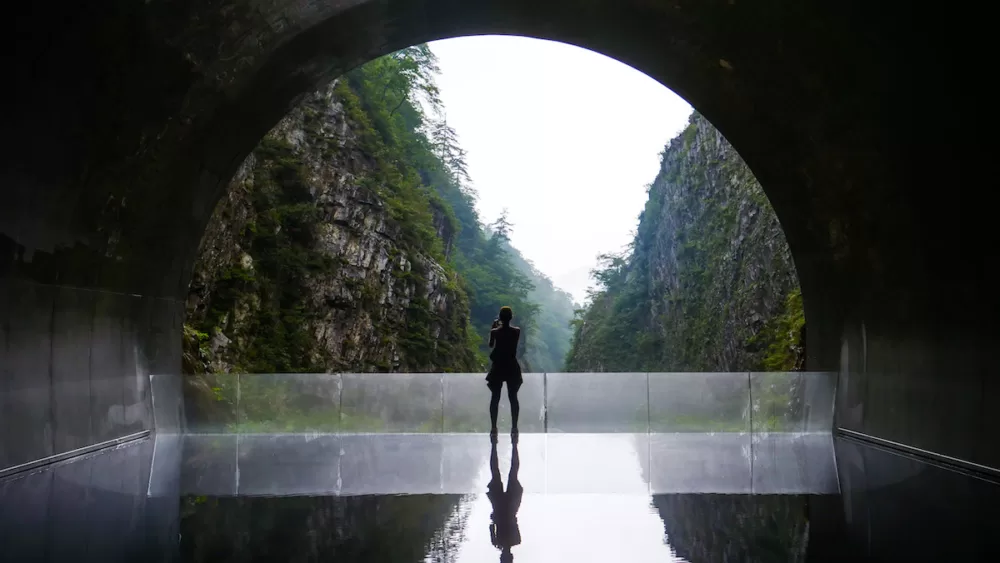
MAD Architects & Kiyotsu Gorge Tunnel
MAD Architects are the ones responsible for the transformation of the Kiyotsu Gorge Tunnel. This architecture firm is known for its innovative and futuristic designs, and in 2018 they renovated and completely transformed the 750-metre tunnel, now known as the Tunnel of Light, creating different art installations.
Here’s a brief explanation of each of the artworks you’ll encounter:
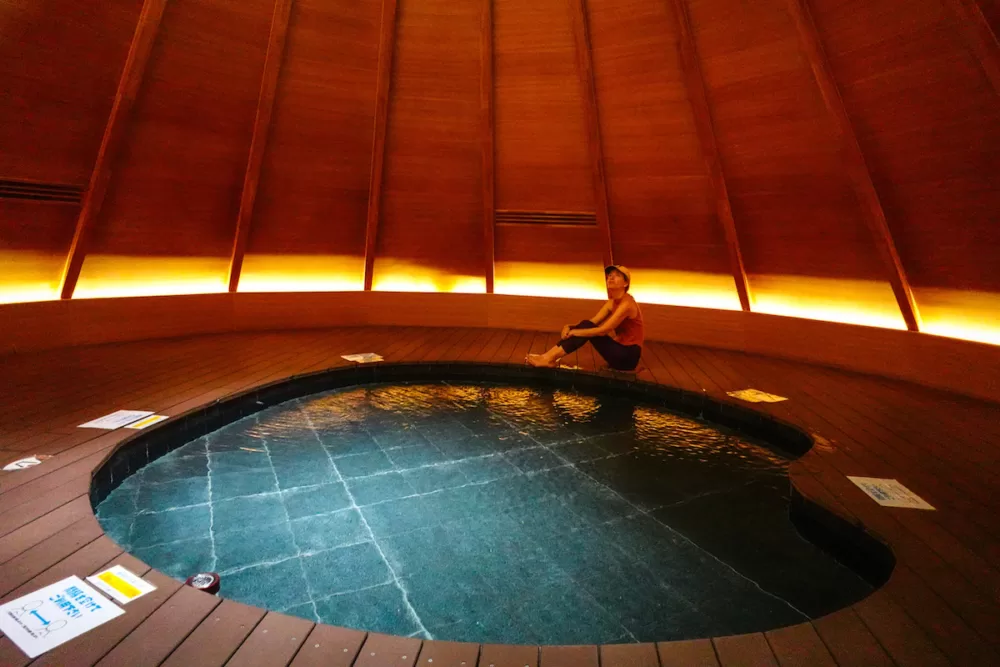
Periscope
The first structure you’ll encounter just before entering the Kiyotsu Gorge Tunnel is Periscope. This is a small structure close to the entrance of the tunnel that features a shop on the ground floor. However, the real attraction is upstairs where you’ll find a foot onsen to dip your feet.
Periscope’s ceiling has a cone shape with a small mirrored opening at the top which reflects the lush landscapes of the Kiyotsu Gorge.
I would recommend visiting Periscope at the end of your visit since it’s a nice way to relax and give your legs a break after walking the length of the tunnel there and back.
The shop on the first floor also sells some nice treats; we opted for chocolate walnut cookies, but they had a wide range of traditional Japanese desserts to choose from.
There are also bathroom facilities on the ground floor should you need them.
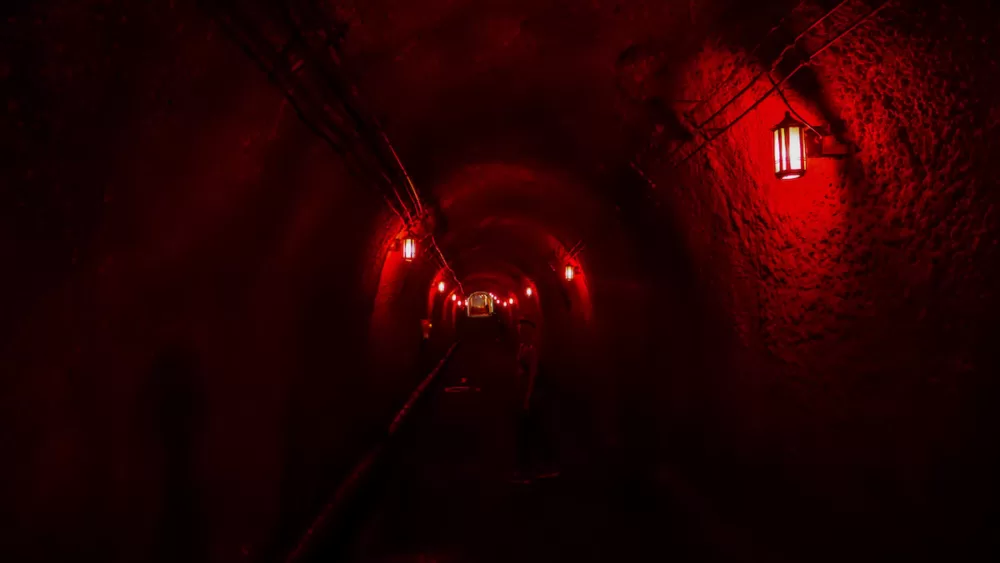
Expression of Color
Once you enter the Kiyotsu Gorge Tunnel, you’ll reach the ticketing booth which is a few meters in on the right-hand side of the tunnel. After paying the cost of admission (¥1000 at the time of our visit), you begin the walk down the 750-metre-long tunnel.
This section of the tunnel is known as the Passageway and the exhibition is called Expression of Colour. This part consists of five different coloured lights paired with some rather ominous chanting music, which leads visitors deeper into the tunnel. The lights go from green to blue to pink to yellow to red.
It’s a little spooky when you’re one of the first people in there walking down a virtually empty tunnel, but it’s all part of the art experience.
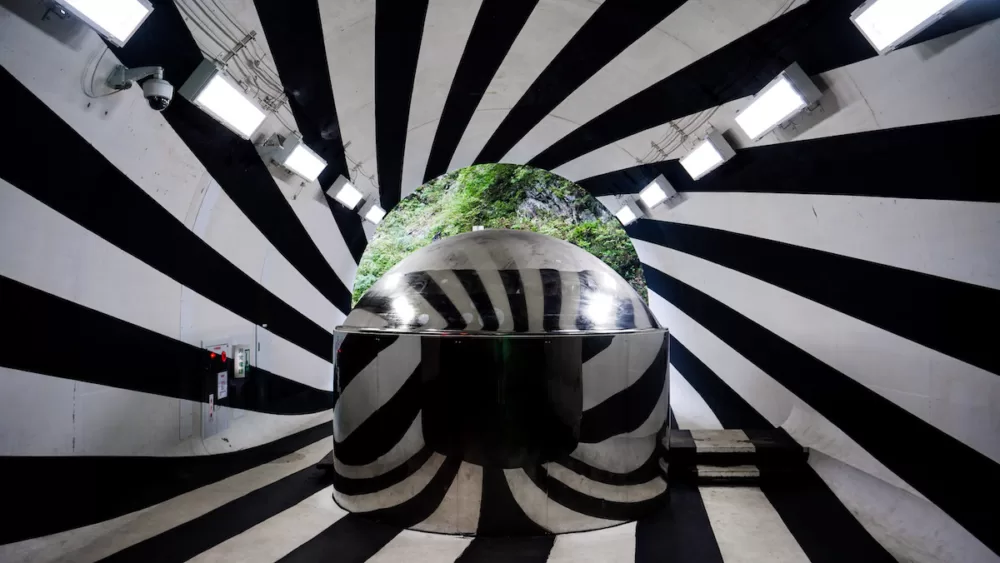
FLOW
Next up, is FLOW which is located on the second viewing platform and is one of the newest additions to the Kiyotsu Gorge Tunnel.
The walls and floors in this space have been painted black and white in a striped swirling effect.
At the centre of this platform is another art installation known as the Invisible Bubble, which serves a rather functional purpose.
Invisible Bubble
The Invisible Bubble of the second platform is actually a toilet! That’s right, this is the only bathroom facility within the Kiyotsu Gorge Tunnel and it’s a work of art in and of itself.
The Invisible Bubble consists of a mirrored dome coated in a metallic film; that means you can see out from the toilet, but nobody can see in.
Because the exterior of this capsule toilet reflects the swirling black and white stripes of the tunnel, it turns into an interesting optical illusion for visitors inside the tunnel.
All this to say, it’s worth a visit even if you don’t need the toilet!
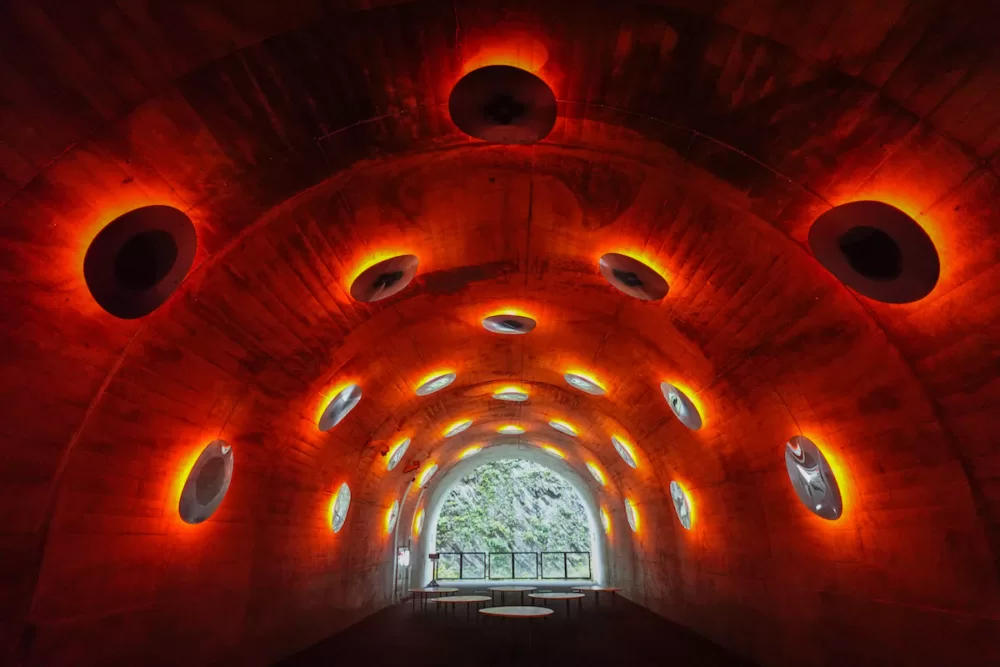
Drops
In the third platform of the Kiyotsu Gorge Tunnel, you’ll find the art installation known as Drops.
As you enter the tunnel, you are met with droplet-like mirrors on the tunnel ceilings and walls lit up by a soft orange neon glow. These mirrors reflect back the rock formations and verdant landscape of the Kiyotsu Gorge and they also reflect the tunnel visitors though in a somewhat distorted form.
The best time to visit this specific platform is at sunset when each of these mirrors is lit by a fiery red light that gives the tunnel a warm feeling. However, we visited in the morning and still enjoyed the tunnel with its orangey glow.
This was my personal favourite art installation in the tunnel because of the interplay between light and nature reflecting in the mirrors, but the next and final attraction is quite an epic one as well.
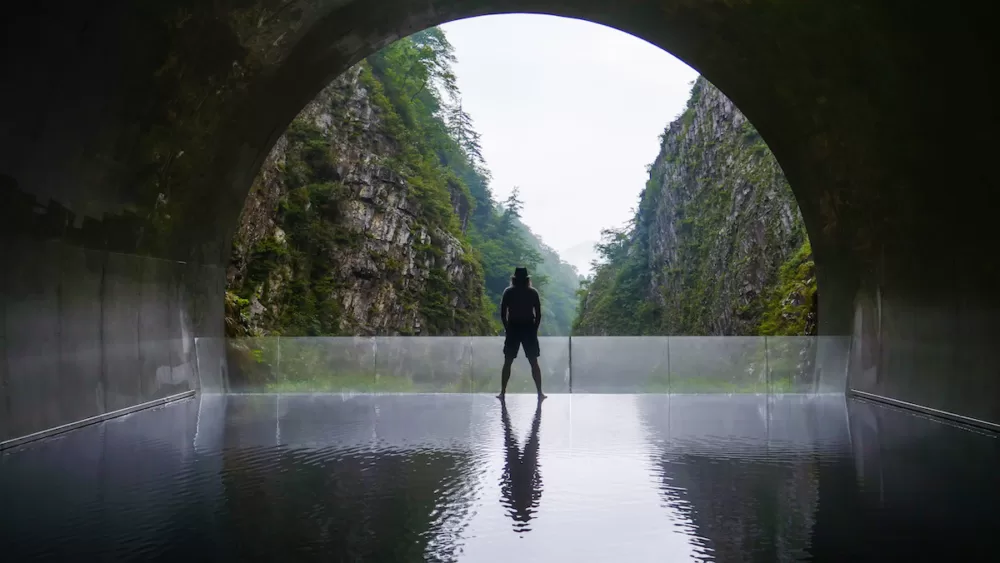
Light Cave
Last but not least, at the end of the Kiyotsu Gorge Tunnel, you’ll reach the Panorama Station which features the iconic Light Cave.
This cave is also known as the Tunnel of Light and it features a tunnel lined with semi-polished stainless steel. On the floor, there’s a very shallow pool with a thin layer of water that acts as a mirror and reflects the green landscape of the gorge.
You can enter the pool barefoot or with shoes on (there are no signs saying so inside the tunnel, but there is a sign confirming so just before you enter the tunnel) and it makes for a very cool photo opportunity as your silhouette reflects in the pool.
The Kiyotsu Gorge Tunnel is one of the coolest places we visited in Niigata Prefecture, so definitely add it to your list if you’re going to be travelling in this corner of Japan!
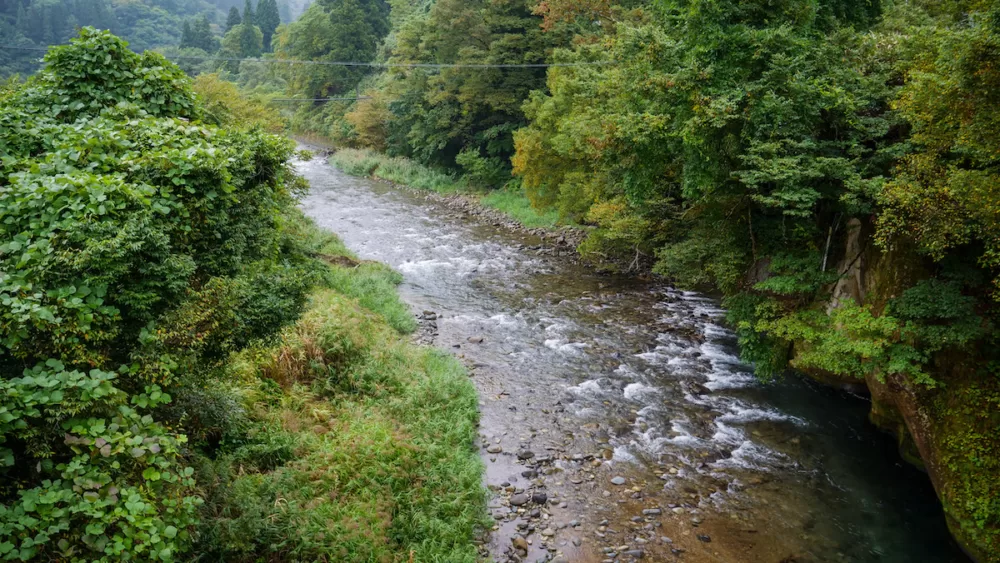
Echigo-Tsumari Art Field
If you enjoy visiting Kiyotsu Gorge and the Tunnel of Light, you may also enjoy the Echigo Tsumari Art Field, an art festival that’s held in the Echigo-Tsumari region of Niigata Prefecture.
The festival takes place across a vast rural area covering about 760 square kilometres. It’s one of the largest international art festivals held in a rural setting, utilizing the natural landscape and abandoned houses, schools, and fields as canvases and venues for artworks.
The Echigo-Tsumari Art Field aims to revitalize rural areas in Japan that have been facing challenges like depopulation and ageing. The festival connects contemporary art with the local culture, community, and natural environment. It also encourages visitors to rethink the relationship between humans and nature, and the role of art in society.
The festival features a wide range of artworks, including installations, sculptures, performances, and interactive projects. These works are created by both Japanese and international artists, often in collaboration with local residents. The artworks are spread throughout the region, encouraging visitors to explore the countryside.
Local residents play a crucial role in the festival. They participate in art projects, offer accommodations in their homes, and share their knowledge and traditions with visitors and artists. This community involvement is a key aspect of the festival’s success and uniqueness.
The main festival is held every three years, with smaller events and art installations remaining accessible throughout the year. The next festival is in 2024!
